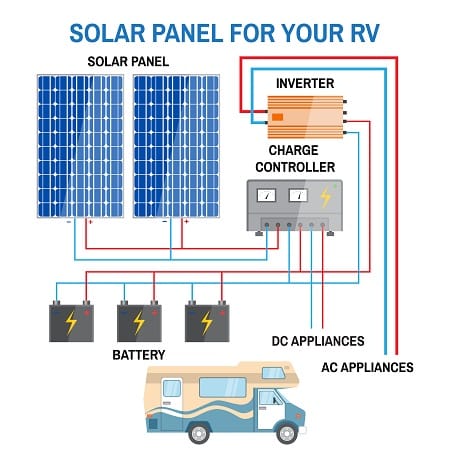
RV Inverter Transfer Switch
When you are not plugged in at a campground pedestal, sometimes you still need to run the 120-volt electrical system. When you’re not plugged in, the generator set can be used for 120-volt power. Many of your RV’s systems, such as the water pump and the lights are powered by the 12-volt batteries.
An RV’s 120-volt electrical system goes through a central distribution panel where all of the fuses and circuit breakers are. This panel needs to handle both 120-volt and 12-volt systems.
The easiest and cheapest way to feed in the 120-volt power from the generator is to hardwire a power cord from the generator to the breaker panel’s inputs.
When you’re not plugged in at a campground, the cord is plugged into the generator’s outlet to power the RV’s 120-volt electrical systems. While this method is cheap and easy, it’s not always convenient. Another method is to install an automatic transfer switch.
Automatic Transfer Switch
An automatic transfer switch is a three-way switch that will switch power between two inputs and connect it into a single output. The automatic transfer switch is installed before the breaker panel. The RV’s power cord will be connected to one of these inputs and the generator will be hard-wired to the other input.
When the transfer switch needs to switch between power sources, it will drop one power input and then connect to the other power input. A manual transfer switch needs to be switched manually, but an automatic transfer switch does this automatically. A circuit board controls the switch.
The automatic transfer switch used on RVs is a generator priority, which means that when the transfer switch detects power coming from the generator, it will switch over to the generator drop the shore power connection. When it doesn’t detect power coming from the generator, it will connect to shore power.
Transfer switches are designed to prevent back-feeding of electrical power; that means only one power source is connected so that electricity doesn’t go back down the other input line. Also, RV transfer switches usually have a built-in delay, allowing the generator to warm up and come up to speed before switching the electrical load. This prevents stalling that could cause the generator to shut off if a heavy load, such as running the air conditioner, is too big of a power draw. Switch off your air conditioner or microwave oven when starting or stopping the generator. This will reduce the current load, and avoid blowing a fuse or tripping a breaker.
Related Video:
